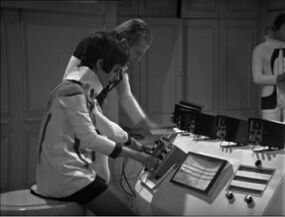Ionisation: Difference between revisions
m (Bot: Cosmetic changes) |
No edit summary |
||
| Line 1: | Line 1: | ||
{{wikipediainfo | {{wikipediainfo}} | ||
As [[Jan Garrett|Miss Garrett]] told the [[Second Doctor]], [[Jamie McCrimmon|Jamie]] and [[Victoria Waterfield|Victoria]] in the year [[5000]], '''ionisation''' was "a method of intensifying the [[Sun]]'s heat onto the Earth's surface, but into particular areas". The Doctor simplified this explanation for Jamie, saying that it was "like a [[magnifying glass]]". | |||
== 21st-century science == | == 21st-century science == | ||
| Line 12: | Line 13: | ||
== Behind the scenes == | == Behind the scenes == | ||
"Ionisation" as used in ''The Ice Warriors'' superficially has nothing to do with real world ionisation. Ionisation is about creating an | "Ionisation" as used in ''The Ice Warriors'' superficially has nothing to do with real world ionisation. Ionisation is about creating an [[ion]], a process which doesn't produce significant heat. Ionisation, as understood by real-world physicists, is usually about redistributing the [[electron]]s between [[atom]]s in a [[compound]], thereby giving individual atoms a different overall charge. In the real world, it is not — in ''any'' way — "like a magnifying glass" focusing the sun's heat. | ||
[[Category:Physics]] | [[Category:Physics]] | ||
[[Category:Chemistry]] | [[Category:Chemistry]] | ||
[[Category:Physics from the real world]] | [[Category:Physics from the real world]] | ||
[[Category:Chemistry from the real world]] | [[Category:Chemistry from the real world]] | ||
Revision as of 16:35, 29 November 2019
As Miss Garrett told the Second Doctor, Jamie and Victoria in the year 5000, ionisation was "a method of intensifying the Sun's heat onto the Earth's surface, but into particular areas". The Doctor simplified this explanation for Jamie, saying that it was "like a magnifying glass".
21st-century science
In 2016, Miss Quill assigned her physics class a problem about linking photoelectric effect and ionisation. Tanya Adeola pointed out that a typical mistake was to link work function to electrons escaping from individual atoms. (PROSE: The Stone House)
6th-millennium science
It was the method the Doctor recommended that Clent take to solve the problem of the Second Ice Age.
The process was not without its difficulties. It required perfect control of the ioniser technology, lest areas of the Earth become uselessly super-heated. As Clent pointed out, ionisation could "melt rocks". Moreover, it had to be done extremely carefully to prevent widespread flooding.
A series of ioniser bases were dotted over the Earth's surface. These normally had to work in coordination with each other to effect what was called "the World Plan" — that is, the effort to carefully re-heat the Earth. However, to counteract the Ice Warrior threat, the ioniser base under Clent's control in Europe used its ioniser independently of others to defeat the Ice Warriors with intense heat. (TV: The Ice Warriors)
Behind the scenes
"Ionisation" as used in The Ice Warriors superficially has nothing to do with real world ionisation. Ionisation is about creating an ion, a process which doesn't produce significant heat. Ionisation, as understood by real-world physicists, is usually about redistributing the electrons between atoms in a compound, thereby giving individual atoms a different overall charge. In the real world, it is not — in any way — "like a magnifying glass" focusing the sun's heat.

